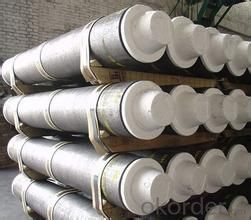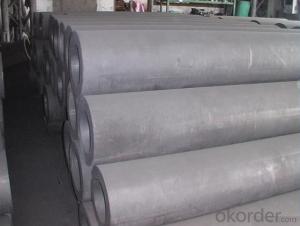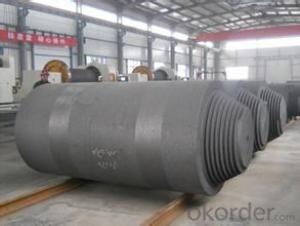Carbon Electrode With Φ500~Φ700 S Grade
- Loading Port:
- Tianjin
- Payment Terms:
- TT OR LC
- Min Order Qty:
- 20 m.t.
- Supply Capability:
- 800 m.t./month
OKorder Service Pledge
OKorder Financial Service
You Might Also Like
Carbon Electrode With Φ500~Φ700 S Grade
Product Description
Carbon Electrode is abaked electrode used in submerged arc furnaces for delivering power to the charge mix. Electrode is added to the top of the electrode column cylindrical form. Electrode is essentially a mix of Electrically Calcined Anthracite (ECA) or Calcined Petroleum Coke (CPC) with Coal Tar Pitch and is baked for weeks, it is widly used for ferroally productiong, silicon metal production etc.
Features
1:carbon eletrode
2:for ferroalloy,calcium carbide, silicon metal, manufacture
Graphite/Carbon Electrode Paste Specification
| PARAMETER UNIT GUARANTEE VALUE | ||||||
| Items | Φ500~Φ700 | Φ750~Φ960 | Φ1020~Φ1400 | |||
| Rs μΩ.m | ≤45 | ≤38 | ≤45 | ≤38 | ≤40 | |
| Bulk Desity g/cm3 | ≥1.55 | ≥1.58 | ≥1.55 | ≥1.58 | ≥1.55 | ≥1.58 |
| Bending Strength MPa | 3.5~7.5 | 4.0~7.5 | 3.5~7.5 | 4.0~7.5 | 3.5~7.5 | 4.0~7.5 |
| Compressive Strength MPa | ≥20.0 | ≥20.0 | ≥20.0 | ≥20.0 | ≥19.0 | ≥19.0 |
| Compressive Strength MPa | 3.2~4.8 | 3.0~4.6 | 3.2~4.8 | 3.0~4.6 | 3.2~4.8 | 3.0~4.6 |
| Ash % | ≤2.5 | ≤2.0 | ≤2.5 | ≤2.0 | ≤2.5 | ≤2.0 |
Picture

We Also supply all kind of carbon electrode paste and below materials, please contact us if you have any enquiry about it.
Calcined Anthracite
Calcined Petroleum Coke
Coke (Met Coke, Foundry Coke, Semi Coke)
- Q:How does carbon impact the availability of clean water resources?
- The availability of clean water resources can be significantly influenced by carbon. One way carbon affects water resources is by contributing to climate change. The burning of fossil fuels, mainly responsible for increased carbon emissions, leads to higher global temperatures and disrupts the water cycle. This disruption results in more frequent and severe droughts in certain regions, while others face increased rainfall and flooding. The melting of glaciers and snowpacks, which are essential sources of freshwater for many communities, is also affected by climate change. As carbon emissions warm the planet, glaciers and snowpacks melt at an accelerated rate, reducing the water supply in rivers and streams that rely on these natural storages. This ultimately leads to water scarcity, affecting drinking water availability, agricultural irrigation, and industrial water usage. Moreover, the quality of water resources can be impacted by carbon pollution. Carbon dioxide dissolves in water and reacts with it, causing a decrease in pH levels and increased acidity. This process, known as ocean acidification, is particularly harmful to marine ecosystems and organisms that rely on carbonate ions to build their shells or skeletons. As these organisms struggle to survive, it disrupts the balance of entire aquatic ecosystems, which then affects the availability of clean water resources. Additionally, carbon-based pollutants from human activities, such as industrial processes or agricultural runoff, can contaminate water sources. Pesticides, fertilizers, and hydrocarbons, which are carbon-based chemicals, can infiltrate groundwater or be washed into rivers and lakes, compromising their quality and rendering them unsuitable for drinking or other uses. In conclusion, the impact of carbon on the availability of clean water resources is complex. It affects the quantity of water through changes in the water cycle, reduces water quality through acidification and pollution, and disrupts ecosystems that rely on water resources. Addressing carbon emissions and mitigating climate change is crucial to protect and ensure the availability of clean water for current and future generations.
- Q:How is carbon used in the steel industry?
- The steel industry heavily relies on carbon as it plays a crucial role in the production and enhancement of steel. Carbon is added to iron in the fundamental process that transforms it into steel, resulting in the desired properties of hardness, strength, and durability. In steelmaking, carbon is primarily used as an alloying element to improve the mechanical properties of steel. The carbon content in steel can vary depending on the desired grade and application, ranging from 0.1% to 2%. Low carbon steel, with a carbon content below 0.3%, is commonly used for applications that require good formability and weldability. On the other hand, high carbon steel, with a carbon content above 0.6%, is used for applications that demand high strength and hardness. Carbon also plays a crucial role in the heat treatment process of steel. Through carburizing, steel undergoes a heating process with carbon-rich gases or solids to increase the carbon content at the surface. This results in a hardened surface layer with improved wear resistance, while maintaining a tough and ductile core. Additionally, carbon is essential in the use of electric arc furnaces (EAFs) in steelmaking. EAFs utilize electricity to melt scrap steel and other raw materials. Carbon is introduced during this process to reduce the oxides present in the raw materials, allowing for efficient steel production. In conclusion, carbon is widely utilized in the steel industry to achieve the desired properties of steel, enhance its mechanical properties through heat treatment, and enable efficient steel production. This versatile element enables steel to be used in a wide range of applications across various industries.
- Q:What are the effects of carbon emissions on the stability of estuaries?
- Estuaries, which are highly productive and diverse ecosystems, are greatly impacted by carbon emissions. These emissions, primarily in the form of carbon dioxide (CO2), contribute to climate change and ocean acidification, resulting in detrimental effects on estuaries. Sea-level rise is one of the most significant consequences of carbon emissions on estuaries. As global temperatures increase, the melting of glaciers and ice caps causes sea levels to rise. Estuaries, being low-lying areas where rivers meet the sea, are particularly vulnerable to this rise. Consequently, higher water levels lead to increased flooding, erosion, and saltwater intrusion into freshwater systems within estuaries, negatively affecting their overall stability. Furthermore, the concentration of CO2 in the atmosphere leads to ocean acidification. When CO2 dissolves in seawater, it forms carbonic acid, which lowers the water's pH. This acidification has detrimental effects on marine life within estuaries, especially organisms with calcium carbonate shells like shellfish and oysters. The increased acidity makes it more challenging for these organisms to build and maintain their shells, resulting in reduced populations and biodiversity in estuaries. Climate change, caused by carbon emissions, also alters temperature and precipitation patterns in estuaries, disrupting the delicate balance of saltwater and freshwater. Estuaries rely on this balance to support their unique ecosystems. Changes in temperature and precipitation disturb this equilibrium, causing significant shifts in species composition and distribution. Some species may struggle to adapt, while invasive species may thrive, further destabilizing estuarine ecosystems. In conclusion, the effects of carbon emissions on estuaries are extensive and varied. Rising sea levels, ocean acidification, and climate-induced changes in salinity and freshwater availability all contribute to the degradation of estuaries and the loss of biodiversity. To protect and preserve these essential ecosystems for future generations, it is crucial to reduce carbon emissions and mitigate climate change.
- Q:What is latent carbon?
- With prochiral carbon atoms called prochiral molecules.For potential chiral compounds, can also be used to determine the order of rule configuration. For example, an atom of hydrogen by deuterium methylene propionate (D) replaced, if converted into R configuration, the hydrogen atom is called latent -R (pro-R) hydrogen atoms into S; if the configuration is called latent -S (pro-S the hydrogen atom).For medical workers, prochiral is an important concept. Almost all of the biological chemical reaction is controlled by the enzyme, the enzyme for prochiral molecules not symmetrically reaction, so they are able to identify two identical atoms or atomic groups, because they are chiral compounds. For example two methylene citric acid and only one methylene by enzymes (from rat liver) into carbonyl group.
- Q:Process for producing carbon fiber board
- Method for making carbon fiber sheet:1, first determine the thickness of the plate to be made2 calculate the required number of plies according to the thickness3, and then according to 0 degrees, 45 degrees, 90 degrees, -45 degrees in the order of stacking.4, and then molding it!Now carbon fiber board, in fact, many in the middle are entrained with some glass fiber cloth, of course, there are all carbon, a little more expensive!
- Q:How does carbon affect the formation of earthquakes?
- Carbon does not directly affect the formation of earthquakes. Earthquakes are primarily caused by the movement of tectonic plates, which are large sections of the Earth's crust that float on the semi-fluid layer below. These plates can collide, slide past each other, or move apart, causing stress to build up along the plate boundaries. When the stress becomes too great, it is released in the form of an earthquake. However, carbon can indirectly impact the occurrence of earthquakes through its role in the Earth's carbon cycle and its contribution to climate change. Carbon dioxide (CO2) is a greenhouse gas that is released into the atmosphere through various human activities, such as burning fossil fuels. This excess CO2 in the atmosphere leads to global warming and climate change. Climate change can have several effects on the Earth's crust, some of which may indirectly influence seismic activity. For example, the melting of glaciers and polar ice caps due to global warming can lead to changes in the distribution of mass on the Earth's surface. This redistribution of mass can cause the Earth's crust to adjust, leading to increased stress along fault lines and potentially triggering earthquakes. Additionally, changes in precipitation patterns and the hydrological cycle caused by climate change can affect groundwater levels and pore pressure within rocks. These changes in water content can alter the strength and stability of fault lines, potentially making them more prone to slipping and causing earthquakes. It is important to note that the direct impact of carbon on earthquake formation is minimal compared to the primary factors such as plate tectonics. However, the relationship between carbon emissions, climate change, and seismic activity is an area of ongoing research and scientific investigation.
- Q:How does carbon affect the formation of volcanic eruptions?
- Carbon plays a significant role in the formation of volcanic eruptions. When carbon-rich magma rises to the Earth's surface, it releases large amounts of carbon dioxide gas. This gas builds up pressure within the volcano, contributing to the explosive nature of volcanic eruptions. Additionally, carbon dioxide dissolved in the magma can cause the magma to become more fluid, making it easier for it to reach the surface and result in volcanic activity.
- Q:Whether the CO2 content in the boiler smoke can not be measured, the measurement of carbon content of fly ash ah? @ @ Thank you very much!!!
- No The amount of unburned carbon in the fly ash is not carbon dioxide.CO2 measurements are simple.
- Q:How is carbon used in the production of cosmetics?
- Carbon is used in the production of cosmetics in various forms. It can be found in activated charcoal, which is used for its ability to absorb impurities and toxins from the skin. Carbon black, a pigment made from carbon, is used to provide color in cosmetics such as eyeliner, mascara, and lipstick. Additionally, carbon-based compounds like carbonates and carbomers are used as stabilizers and thickeners in cosmetic formulations.
- Q:How does carbon affect the ozone layer?
- Carbon does not directly affect the ozone layer. However, certain carbon compounds, such as chlorofluorocarbons (CFCs) and hydrochlorofluorocarbons (HCFCs), can indirectly contribute to the depletion of the ozone layer. These compounds contain chlorine and bromine atoms, which are released into the atmosphere when the compounds are broken down by sunlight. Once in the atmosphere, chlorine and bromine atoms can catalytically destroy ozone molecules, leading to a thinning of the ozone layer. When a chlorine or bromine atom comes into contact with an ozone molecule, it reacts with it, breaking it apart and forming a chlorine or bromine oxide molecule and a regular oxygen molecule. The chlorine or bromine oxide molecule can then react with another ozone molecule, continuing the cycle and depleting the ozone layer. While carbon itself does not directly contribute to ozone depletion, the production and release of carbon compounds like CFCs and HCFCs result from human activities. These compounds were widely used in various industries, such as refrigeration, air conditioning, and aerosol propellants, until it was discovered that they were harmful to the ozone layer. The Montreal Protocol, an international treaty signed in 1987, aimed to phase out the production and use of these ozone-depleting substances. Reducing carbon emissions, however, is crucial in addressing another environmental concern – climate change. High levels of carbon dioxide and other greenhouse gases in the atmosphere trap heat, leading to global warming. This poses various threats to ecosystems and human societies. By transitioning to cleaner and more sustainable energy sources and implementing measures to reduce carbon emissions, we can tackle both ozone depletion and climate change, safeguarding the health of our planet.
1. Manufacturer Overview |
|
|---|---|
| Location | |
| Year Established | |
| Annual Output Value | |
| Main Markets | |
| Company Certifications | |
2. Manufacturer Certificates |
|
|---|---|
| a) Certification Name | |
| Range | |
| Reference | |
| Validity Period | |
3. Manufacturer Capability |
|
|---|---|
| a)Trade Capacity | |
| Nearest Port | |
| Export Percentage | |
| No.of Employees in Trade Department | |
| Language Spoken: | |
| b)Factory Information | |
| Factory Size: | |
| No. of Production Lines | |
| Contract Manufacturing | |
| Product Price Range | |
Send your message to us
Carbon Electrode With Φ500~Φ700 S Grade
- Loading Port:
- Tianjin
- Payment Terms:
- TT OR LC
- Min Order Qty:
- 20 m.t.
- Supply Capability:
- 800 m.t./month
OKorder Service Pledge
OKorder Financial Service
Similar products
New products
Hot products





























